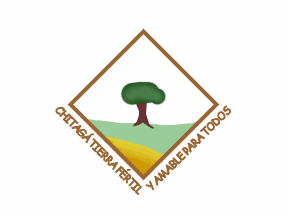 klaus-michael schneider
klaus-michael schneider
Keywords: norte de santander | chitaga | tree |
Links: FOTW homepage | search | disclaimer and copyright | write us | mirrors

Last modified: 2021-08-26 by  klaus-michael schneider
klaus-michael schneider
Keywords: norte de santander | chitaga | tree |
Links: FOTW homepage |
search |
disclaimer and copyright |
write us |
mirrors

image by Eugene Ipavec, 13 August 2008
See also:
Chitagá is a municipality in Norte de Santander Department.
It was founded on 12 December 1804.
The flag of Chitagá is
white and charged with a orange rhombus. Inside the rhombus there
is a tree and fields. Alongside and below the bottom sides of the
rhombus, there is a sloagen written in maroon color:
"CHITAGÁ TIERRA FÉRTIL Y AMABLE PARA TODOS"
Information in Spanish:
"La insigne bandera fue diseñada por la profesora Ana Julia
González de Villamizar.
Sobre un fondo de raso blanco que significa la paz, centrado
aparece un rombo de color anaranjado (por considerarlo neutro) y
dentro de éste un árbol grande de arrayán, recordando la parte
histórico-geográfica de que Chitagá fue fundada en el
“valle de los arrayanales” ; debajo de él, las eras de
un cultivo de papa, principal fuente de economía del pueblo
chitaguense.
Hacia la parte superior, lateral derecho, una nube que proyecta
lluvia hacia el arrayán y que significa la abundancia de agua en
nuestro suelo .
Finalmente, bordeando la mitad inferior del rombo, un letrero en
letras marrones que dice : “ CHITAGÁ TIERRA FÉRTIL Y
AMABLE PARA TODOS"
Source: municipal
web site.
Dov Gutterman and Felipe Carillo, 8 August 2008
Translated from municipal
web site:
"The flag was designed by Pr. Ana Julia González de
Villamizar. On a plain white background meaning peace
is placed, centered, an orange - this colour being considered as
neutral - rhomb charged with a big "arrayán" tree,
recalling that Chitagá was founded in a place called "The
Valley of the Arrayanales". The lower point of the rhomb is
charged with potatoes, the main source of income of the village.
In the upper right part of the rhomb, a cloud pours rain on the
tree, symbolizing the abundance of water in our soil. The lower
part of the rhomb is bordered with the brown writing
"CHITAGÁ TIERRA FÉRTIL Y AMABLE PARA TODOS",
Chitagá, land fertile and pleasant to all."
The municipal symbols were adopted by Municipal Decree No. 017 in
August 1991.
Several plants from the Family Myrtaceae are called
"arrayán" in Spanish, the most famous of them being
the Common Myrtle (Myrtus communis L.; see the
"Patio of los Arrayanes", the Court of the Myrtles, in
the Alhambra of Granada, Spain). The "arrayán" found
in Colombia is rather Psidium arayan (Kunth) Burret,
a.k.a Myrtus arayan Kunth.
The name "The Valley of the Arrayanales" was coined
by Carlos Vera, the founder of the village; on 12
December 1804, he required the allocation
of "284 square 'varas' in the valley
called 'Llano del Arrayán' to set up a parish temple, a
presbytery, a cemetary, a jail and a village square".
On 24 February 1808, the Judge Manuel José María Vásquez
surveyed the land allocated to Vera and registered 469
inhabitants. The parish of Chitagá was set up by the religious
authorities on 9 June 1808 in Santa Fe and dedicated to St. John
of Nepomuk. The Vice-Roy of New Grenada, Antonio Amar y Borbón,
administratively confirmed the parish on 29 June 1808.
Chitagá was visited six times by the Liberator Simón Bolívar
and is the birth village of General Ramón González Valencia
(1851-1928), the 29th President of the Republic of Colombia
(1909-1910), promoter of the Constitutional reform passed in
1910, which opened a period of peace and industrial
modernization.
Ivan Sache, 15 August 2008
nsacg.jpg)
image from municipal
web site